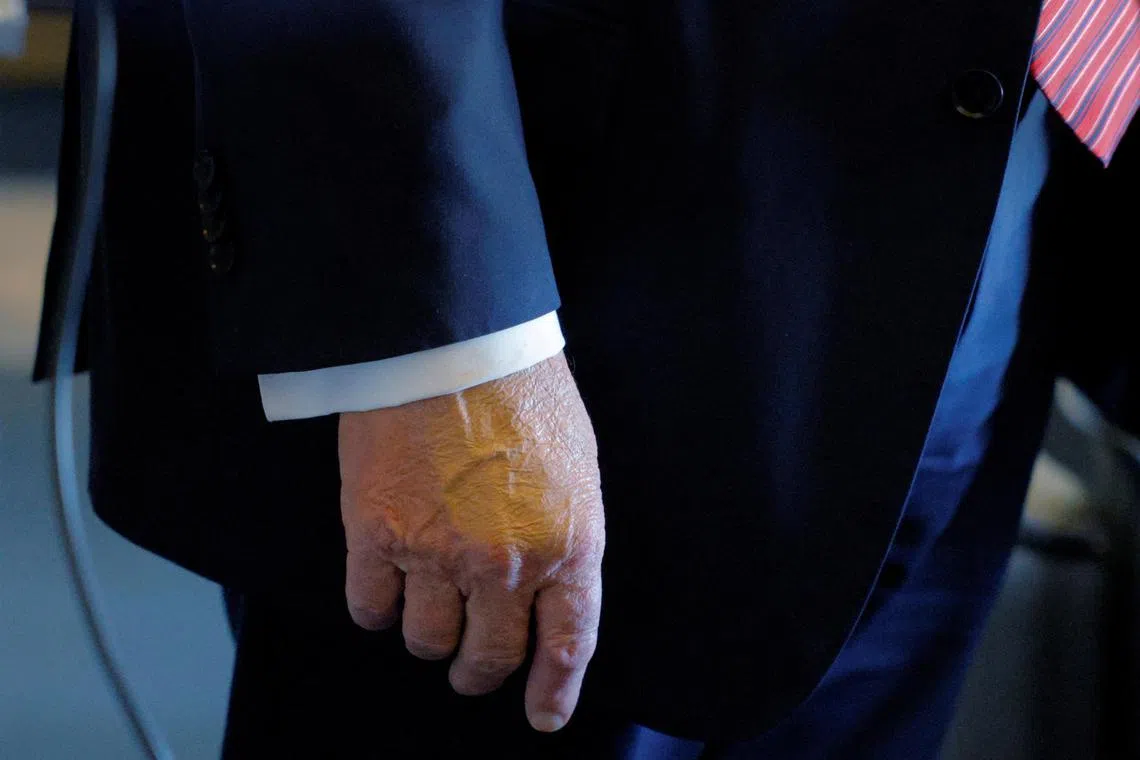Trump was diagnosed with chronic venous insufficiency. What is it?
Sign up now: Get ST's newsletters delivered to your inbox

The White House also noted that US President Donald Trump had some bruising on his hand.
PHOTO: REUTERS
Nina Agrawal
Follow topic:
WASHINGTON - The White House said on July 17 that US President Donald Trump had been diagnosed with chronic venous insufficiency,
The White House press secretary Karoline Leavitt announced the diagnosis while addressing swelling in Mr Trump’s legs and bruising on his hand in recent weeks.
Dr Sean P. Barbabella, the physician to the President, said in a memo that Mr Trump had noticed mild swelling in his lower legs and underwent a comprehensive evaluation, which revealed the condition. He added that the condition was “benign” and common in people older than 70. Mr Trump is 79.
The risk of chronic venous insufficiency, which is estimated to affect 10 per cent to 35 per cent of US adults, increases with age. The condition, which occurs most often in the legs, can cause swelling, as the President experienced.
Other symptoms can include varicose veins, pain, discomfort and, in rare cases, venous ulcers, sores that take unusually long to heal, said Dr Prakash Krishnan, director of endovascular services at the Mount Sinai Fuster Heart Hospital in New York.
Additional risk factors include obesity, pregnancy and smoking. People who have to stand for long periods of time on the job are also at greater risk, Dr Krishnan said.
This is because veins, particularly in the legs, have to pump blood against gravity back up to the heart. They use one-way valves and muscles to help them do that, Dr Krishnan said. But when too much blood pools, as can happen during prolonged standing, the pressure causes veins to dilate and the valves can stretch and become leaky, causing venous insufficiency.
Doctors typically start with conservative treatments, such as compression stockings, to squeeze the legs and help blood move back up to the heart. They also often recommend that patients keep their legs elevated for at least 30 minutes three times a day, and sometimes advise patients to lose weight or perform resistance exercises to improve blood flow.
If those measures fail, doctors might try more intensive treatments, such as a procedure called sclerotherapy, which involves injecting a chemical solution into the affected veins to collapse them. They can also use heat to seal a vein, including with laser treatment. The body will then reroute the blood through other, healthier veins.
The White House also noted that Mr Trump had some bruising on his hand. Dr Barbabella attributed this to irritation caused by repeated hand-shaking and to the use of aspirin, which the President takes as part of his heart health regimen.
As part of the comprehensive evaluation, Mr Trump also had his blood work done and underwent an echocardiogram, Dr Barbabella said. All of the results were within normal limits and revealed no cardiac, renal or systemic issues. “President Trump remains in excellent health,” he wrote. NYTIMES

